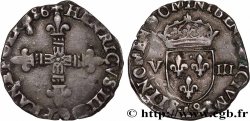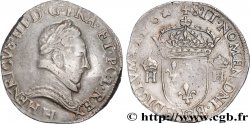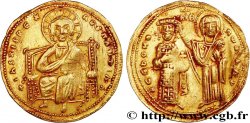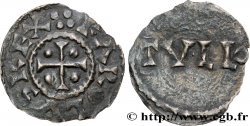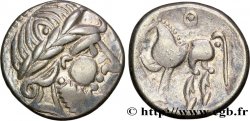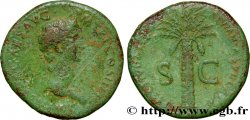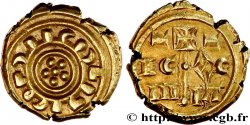Obverse
Obverse legend : HENRICVS. III. D. G. FRAN (MG) ET. POL. RE.X., (LÉGENDE COMMENÇANT À 6 HEURES).
Obverse description : Buste de Henri III à droite, lauré, drapé et cuirassé avec col fraisé ; au-dessous M.
Obverse translation : (Henri III, par la grâce de Dieu, roi des Francs et des Polonais).
Reverse
Reverse legend : + SIT. NOMEN. DOM. BENEDI. M.D.LXXV. (MM)..
Reverse description : Écu de France couronné, accosté de deux C retournés et couronnés.
Reverse translation : (Béni soit le nom du Seigneur).
Commentary
Historical background
HENRY III
(05/30/1574-08/2/1589)
Born in Fontainebleau in 1551, Henri III was the fourth son of Henri II and Catherine de Médicis. First Duke of Anjou, he distinguished himself by his military successes against the Huguenots and was chosen in 1573 as king by the Poles to replace the last of the Jagiellons.. In June 1574, while Catherine de Medici was in charge of the regency, Henri III fled from Poland. He passed through Venice to return to France. In France, Catherine was very unpopular, because of the favors that rained down on her Italian creatures (Strozzi, Gonzague, Birague, Gondi). The king and his mother met in Lyon and reformed the government. The council was limited in number: it was reduced to the queen mother, Birague and Cheverny. The powers of the Secretaries of State were reduced. Sacred in Reims, having married Louise de Vaudémont, Henri III tried to calm the civil war. At court, the king's party clashed with that of his brother, the Duke of Alençon.. In September 1575, Alençon fled and put himself at the head of the Protestant party. In May 1576, Henri III had to sign the edict of pacification of Beaulieu or peace of Monsieur. The victims of Saint Barthélemy were rehabilitated, Protestant worship authorized everywhere outside Paris and in the residences of the Court. Eight places of safety and half-party chambers of justice were granted to Protestants. Damville kept the government of Languedoc and the Duke of Alençon received as an appanage Anjou, Touraine and Berry. The King of Navarre, back in his States, abjured the Catholic religion. The Catholic party was unhappy with this peace. A first Catholic league was created by the Sieur d'Humières in Péronne, Picardy refusing to receive Condé as Governor. Soon, Henri de Guise extended this League to the whole kingdom, with the program of the restoration of royal power and the meeting of the States General.. To counter the Balafré, Henry III declared himself head of the League. The Estates General met in Blois in November 1576, without Protestant representation. The States having declared themselves for the unity of religion, the Protestants took up arms again. The Estates also claimed to establish government control and refused Henry III the subsidies he was asking for.. Catherine joined Damville and the Duke of Alençon, who became Duke of Anjou, heir presumptive. After some Catholic successes, a new peace was signed: it was the Edict of Poitiers of September 1577, which placed some restrictions on the Edict of Beaulieu.. The war resumed in 1580 with the capture of Cahors by the King of Navarre: it was brief, the Protestants aspiring to peace, which was concluded at Fleix in November 1580. The Duke of Anjou carried his ambitions abroad, seeking to marry Elizabeth of England then died in front of Antwerp, which he sought to seize (June 1584). Surrounded by minions and favorites, Henry III tried to strengthen the royal power by grouping his followers around a throne whose prestige he wanted to raise: this is the meaning of the elevation of his favorites, Épernon and Joyeuse, of the reinforcement of the etiquette and the foundation, in 1578, of the Order of the Holy Spirit. Great legislator, he structured the Council but, very spendthrift, failed in the financial reform. After the death of the Duke of Anjou, Henri de Navarre had become the heir presumptive. Henry III had no children, he was discredited. The Guises rallied behind the candidacy of Cardinal de Bourbon and the covert support of Philip III and Pope Sixtus V.. The Holy League was formed by the Treaty of Joinville (December 1584). A Parisian league was formed, where bourgeois and parliamentarians entered. Elboeuf, Aumale and Mercœur raised the province. Faced with this pressure, the king had to sign, on July 18, 1585, an edict of proscription against the Protestants.. Meanwhile, the Pope declared Henry of Navarre stripped of his rights to the throne.. In October 1587, the Duc de Joyeuse was defeated and killed by Henri at Coutras. But the relief army sent by the Protestant princes of Germany was defeated by the Duke of Guise. On May 12, 1588, the latter being in Paris, the city rose up against the king, who had to flee. In July, Henri III signed an edict of union (of the Catholics): heresy was prohibited; Navarre excludes from succession. The States General, convened in Blois, saw the triumph of the League: the king renewed the edict of union and the States refused him any subsidy.. To regain control of power, the king had Guise (December 23, 1588) and his brother the Cardinal de Guise (December 24) assassinated.. The Estates were closed in January 1589. Paris entered into open revolt against the king and put at its head a Council of Sixteen. The Duke of Mayenne, brother of Guise, governor of Burgundy, arrived in Paris in February 1589 and was appointed lieutenant general of the kingdom. The province followed. Henry III only had Dauphiné, Bordeaux, Angers, Tours, Blois and Beaugency. Mayenne marching on Tours, the king had to ally himself with Henri de Navarre. Soon, Paris was besieged by the two sovereigns. It was then that a Jacobin monk, Jacques Clément, assassinated Henri III: it was the first regicide in the history of France.. With Henri III ended the dynasty of Valois which governed France since 1328. The crown passed to his distant cousin Henry of Navarre.







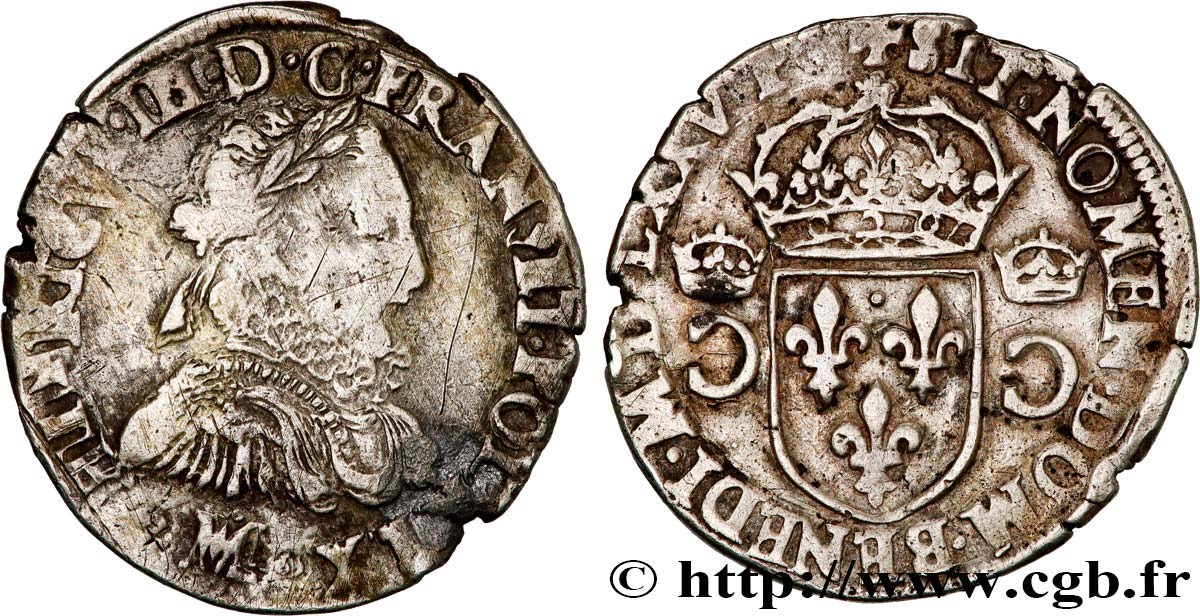
 Report a mistake
Report a mistake Print the page
Print the page Share my selection
Share my selection Ask a question
Ask a question Consign / sell
Consign / sell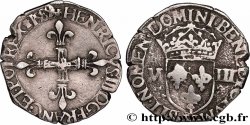
 Full data
Full data

